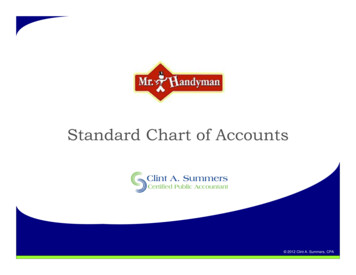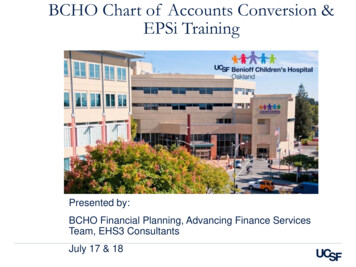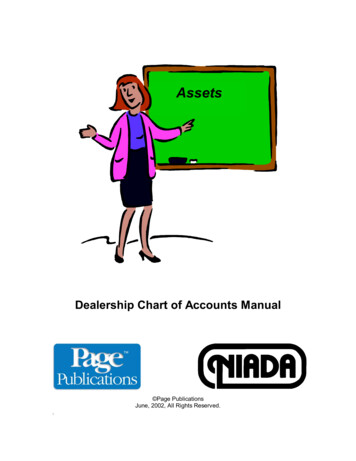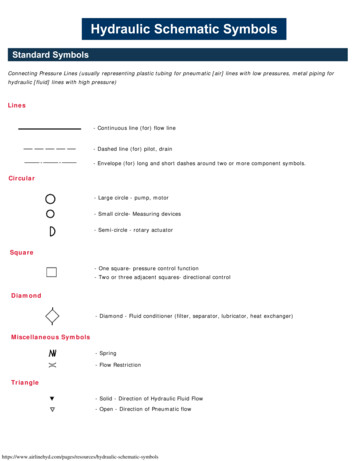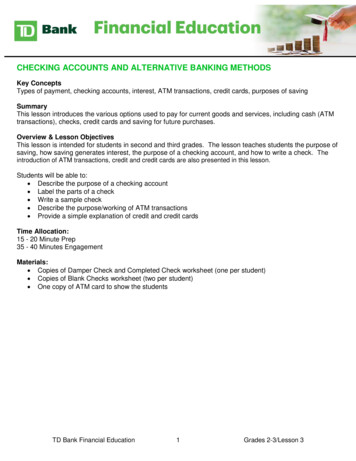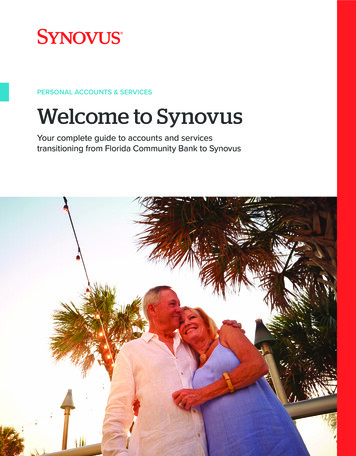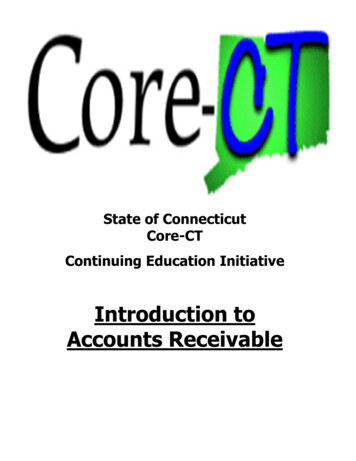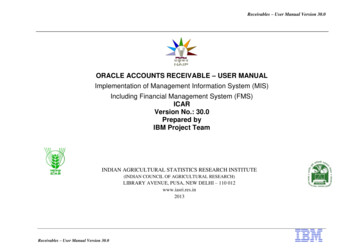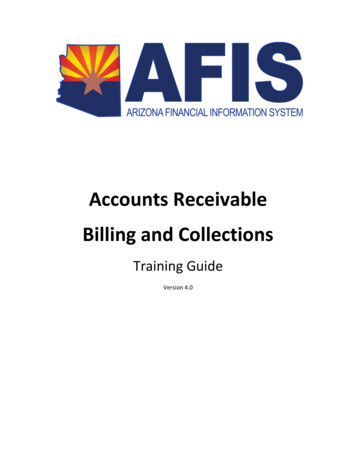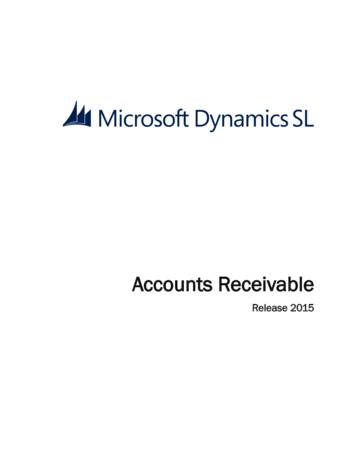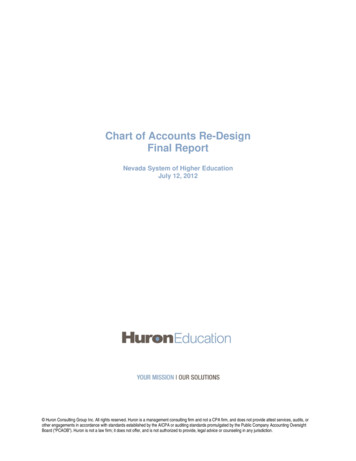
Transcription
Chart of Accounts Re-DesignFinal ReportNevada System of Higher EducationJuly 12, 2012 Huron Consulting Group Inc. All rights reserved. Huron is a management consulting firm and not a CPA firm, and does not provide attest services, audits, orother engagements in accordance with standards established by the AICPA or auditing standards promulgated by the Public Company Accounting OversightBoard (“PCAOB”). Huron is not a law firm; it does not offer, and is not authorized to provide, legal advice or counseling in any jurisdiction.
Table of contentsChart of Accounts Re-Design – Project Overview . 3Project Phases . 3Discovery and Design Phase . 3Overview . 3Current Chart of Accounts Review . 3Our Understanding of the Current Chart of Accounts . 3NSHE Institutions . 4Interviews and Data Gathering . 6CoA Design Prototype . 7Proof of Concept Phase . 8CoA Finalization/Recommendation Phase . 8Detail Chart of Accounts Structure/Design . 8Chart of Accounts Overview . 8Chart of Accounts Structure . 8Segments . 9Definition and Purpose . 10Account . 10Entity . 10Organization . 10Fund Type . 10Fund . 10Function . 11Project . 11Program . 11Activity . 11Location. 11Usage Requirements by Transaction Type . 12Value Hierarchy . 13Account . 13Entity . 13Organization. 13Fund Type . 13Fund . 14Function . 14Project . 14Program . 14Activity . 14Location . 14Summary of Proof of Concept Results . 15Other Considerations . 15Value Ranges and Development . 15Interfacing Systems and Applications . 15System Selection . 16Appendix A . 17Appendix B . 22Appendix C . 26Appendix D . 272
Chart of Accounts Re-Design – Project OverviewProject PhasesThe Chart of Accounts Re-Design Project (project), initiated in mid-March 2012, consisted of threeprimary phases: Discovery and Design, Proof of Concept, and CoA Finalization/Recommendation. Asummary of each phase is provided below.Discovery and Design PhaseOverviewThe objective of the discovery and design phase was to develop an understanding of the fiscalmanagement and reporting needs, or requirements, at multiple organizational levels within each of theNSHE institutions, and at the system level. In order to develop this understanding, the project was initiallyfocused on data gathering and analysis. This included the following activities: Review of the current Chart of Accounts (CoA) – structure, values and institutional usage.High level review of the organizational structure within each institutionWeb review of institutional mission, major programs and objectivesInterviews with institutional representatives including central administration, academicdepartments and auxiliary operations.Once requirements were gathered and understood, a review of CoA structure options was conducted anda high level fit/gap evaluation between CoA options and NSHE requirements was completed. The finalstep in the Discovery and Design project phase was the development of an initial CoA structureprototype.Current Chart of Accounts ReviewOur goal in reviewing the existing Chart of Accounts was focused on developing an understanding of thestructure, account values and current usage as an informational baseline to inform our interviews withfiscal data users and managers. As we held discussions and gathered information regarding theinstitutions’ fiscal management needs, we sought to understand the extent to which the current CoA metthose needs. Our intent was to ensure that elements of the current CoA that work well were not “lost” inthe redesign, and that those elements of the existing structure that posed challenges to fiscalmanagement and reporting were addressed.Our Understanding of the Current Chart of AccountsIn connection with recording revenues and expenses, we understand that the Chart of Accountsestablished in NSHE’s current financial system, Advantage, consists of two primary components, anaccount number, and an object code and sub-object (or a revenue code and a sub-revenue code). Theaccount captures information regarding the unit responsible for the transaction, funds used to support thetransaction, and purpose of the transaction (unique activity, project or program). The object and subobject are intended to record information regarding the nature of the transaction. For example, the objectidentifies an expense as faculty salary, office supply or travel. An additional field, Activity, is used tocategorize expenditures by NACUBO function. It is assigned to each account at set up and defaults oneach transaction. In addition to the Accounts and Object Codes used in connection with revenue andexpense transactions, Advantage uses a separate set of balance sheet accounts. Finally, an accounttype, identifying each transaction as expense, revenue, asset, liability or fund balance is designated foreach accounting entry. In summary, an expense transaction is recorded by using account, objectcode/sub-object code, activity code, and account type; the offsetting balance sheet transaction isrecorded using a portion of the account number, balance sheet account and account type.3
The current CoA format is consistent across all of the institutions, but each field or segment can be and ismade up of unique values based on each individual institution’s needs. Over time, the definition and/oruse of each of the fields has been expanded based on institutional needs and each field may havemultiple uses in terms of the type of information captured.The Account is used to track revenues and expenditures associated with specific programs, activities,projects, and or departments. Each account is unique to an institution. It consists of 11 characters in totaland is comprised of three components, fund, agency and organization (xxxx-xxx-xxxx). Fund, a four character field, is used to identify major sources of funding, e.g., stateappropriations, federal grants and contracts, endowments, gifts, etc.Agency, a three character field, is primarily used to identify the major organizational units(divisions and/or departments).Organization, a four character field, is used to identify the cost-center. It may represent a uniquerestricted fund, sponsored project, activity or program.Once a combination of fund, agency and organization is established, it is “locked” together in an “account”for use in processing transactions. Each four character organization is used in only one combination ofFund, Agency and Organization. . It is only with extremely rare exception that an organization value wouldbe used in combination with more than one Fund or Agency. The Advantage system allows setup of bothmulti-year and single year accounts. However, not all of the NSHE institutions use the multi-yearfunctionality.The two digit object code and two digit sub-object code are used to describe the major types ofexpenditures. The object codes are shared across all of the institutions and the sub-object codes areunique to each institution. Object codes provide a high-level grouping of each type of expenditure, forexample, payroll, travel, etc. While the sub-object codes provide a detailed breakdown for each type ofexpenditure, such as travel-in state, travel-out of state, travel-foreign, etc.The two digit revenue code and two digit sub-revenue code are used to describe the type of revenue orincome generated by NSHE’s institutions. Like the object codes, the revenue codes are shared across allthe institutions and the sub-revenue codes are unique to each institution. Similar to object codes, revenuecodes provide a high-level description of the revenue. For example, tuition and fees, sales and services ofeducational activities, sales and services of auxiliary services, etc. The sub-revenue codes provide detail.For example, in connection with the tuition and fees revenue code, sub-codes may include registrationfee - undergrad, registration fee – graduate, application fee, transcript fee, etc.The balance sheet accounts are a four digit identifier associated with specific assets, liabilities and fundbalance accounts. They are used in combination with fund to summarize transactions. Examples ofbalance sheet accounts include cash in bank, buildings, FICA payable, fund balance, etc. Overall, thesame set of high-level values is used by all the institutions.The activity field is a four digit identifier assigned to each account at creation or point of budgeting. Thisfield captures the NACUBO functional classification for financial reporting. Examples include research,public service and academic support. Overall, the same set of high-level values is used by all theinstitutions.The account type field is a two digit transaction type identifier. Specifically, it is used to classifytransactions as assets, liabilities, equity, revenue, or expenditures. Generally, the same set of values isshared across the institutions.NSHE InstitutionsThe Nevada System of Higher Education is composed of eight distinct and diverse institutions thatconduct research, provide graduate, undergraduate and vocational instruction, conduct auxiliary activitiesand interact with and support the local communities. Each institution consists of multiple divisions,4
organizations and programs and is supported through multiple sources of funding. Certain of theinstitutions manage robust research programs with extramural funding while others are focused onproviding vocational instruction. Understanding the mission, programs and culture of each institution wasof key importance in arriving at a CoA design that meets the needs of each institution.NSHE is made up of two doctoral granting research universities, a state college, four community collegesand one research institution, as follows: University of Nevada, Las Vegas (UNLV)o Has over 28,000 students and 3,100 faculty and staffo Has internationally recognized programs, such as hotel administration and creativewritingo Has a law school, architecture school and dental schoolo Has a main campus and two satellite campuseso Received over 40.8 million in external funding supporting research University of Nevada, Reno (UNR)o Has over 18,000 students and 1,000 faculty and staffo Is the oldest institution in Nevadao Has internationally recognized programs that include engineering, cellular and molecularbiology, and earth sciences and miningo Has a medical school with campuses in Las Vegas and Reno, and a healthcare networkthat expands throughout Nevadao Is one of the top 120 universities for funded research Nevada State College (NSC)o Has over 3,000 students and 70 full-time facultyo Is the newest institution of higher learning in Nevadao Has one main campus, one satellite campus and several sites throughout the stateo Offers bachelor’s degrees in over 20 fields of study College of Southern Nevada (CSN)o Has over 40,000 students and 2,100 faculty and staffo Is considered Nevada’s largest collegeo Has three main campuses and eight centerso Offers more than 200 degree and certificate options in more than 120 fields of study Great Basin College (GBC)o Has over 3,800 students and 200 faculty and staffo Service area spans 62,000 square miles in six countieso Has one main campus and four centerso Is the only college in the system with student dormitorieso Has16 bachelor’s degree programs, 27 associate degree programs and 16 certificateprograms Truckee Meadows Community College (TMCC)o Has over 13,000 students and 400 faculty and staffo Has one main campus and four centerso Has over 50 programs leading to associate degrees and certificates Western Nevada College (WNC)o Serves over 5,300 studentso Has three campuses and five centers5
o Offers more than 40 academic degrees and certificates, including a four year Bachelor ofTechnology degree in Construction ManagementDesert Research Institute (DRI)o Is the only NSHE non-teaching institutiono Receives most funding from federal, state, and local grants and contractso Has approximately 50 faculty members that teach and advise students at UNR, UNLVand NSC in Atmospheric Sciences, Hydrologic Sciences, Anthropology, Geology,Biology, Chemistry, Engineering and Environmental StudiesThese institutions face ever growing complexity with regard to the financial management of theirprograms and funds. The accounting/financial management system and supporting applications mustprovide NSHE with the tools to ensure the proper handling and reporting of donor and sponsor funds;provide a basis for the drawdown of funds from sponsors; provide financial data and reports to trusteesand other stakeholders; and, support sound fiscal management of the institutions’ auxiliary operations,major functions and activities. Flexible, adaptable and complete financial management systemfunctionality is vital to meet these needs. The CoA design will serve as the basis for meeting these fiscalmanagement requirements and serve as the foundational element of financial system configuration andfunctionality.Interviews and Data GatheringInformation gathering meetings were held with NSHE‘s eight institutions and the System Office.The participants included, core team representatives, campus representatives, and administrativeand academic department personnel. These meetings were conducted as an open forum todiscuss the fiscal mana
o Has16 bachelor’s degree programs, 27 associate degree programs and 16 certificate programs Truckee Meadows Community College (TMCC) o Has over 13,000 students and 400 faculty and staff o Has one main campus and four centers o Has over 50 programs leading to associ

